#Achronal Art
Text
youtube
So I've made another art history video, "Smile! Smile! Smile! - Teeth in Western Art (It's Weirder Than You Think)"
Romans viewed laughter with suspicion, as a sign of low character. They never depicted anyone reputable smiling. And they never ever showed teeth except for scary theatrical characters. Europeans emulating them followed suit in their own art for two thousand years.
And then the façade cracked. And here we are, where smiles are seen as showing happiness and laughter is seen as expressing joy.
I'm a working professional artist and sometime art teacher, and I had a blast putting together this art history video of the extremely strange history of the fashion for never-smiling in historical European art, and how it finally changed.
333 notes
·
View notes
Note
Just wanted to say, I'm appreciative that you linked achronal art that one time forever ago. I really enjoyed the latest video.
everybody should watch my mom's videos
227 notes
·
View notes
Text
THE GAME OF LIFE

art by MiotaOwO on YouTube and Nahida/rukkhadevata/Kusanali is owned by HV/Genshin/Mhiyo
—————————
Based off Nova’s writing/fanfic and Nahida-writes’s writing/fanfic but different
( Nova is @noverenia and Nahida-writes is @nahida-writes, they both inspired this x reader hc)
Tw:demon,genshin sumeru character because what the fuck,Dottore/Zandik,academia being shitty,few sumeru spoliers,being mean,being fucked up,tsunderes??,semi spoliers but people already knew about Nahida/kusanali and Rukkhadevata
Cw: Nahida/rukkhadevata/Kusanali,Buer,Dori, Dottore/Zandik,Nilou,Candace(Kandake),Layla,Faruzan,Dehya,Wanderer/Scaramouche/Kuni(??)Cyno,Tighnari,Collie,Al-haitham
Nahida/Kusanali/rukkhadevata,Dori and are seen as platonic
Nahida/Kusanali , rukkhadevata , and Buer are all technically different
because Nahida/Kusanali is child version of rukkhadevata,rukkhadevata is adult version of Nahida and Buer is the demon version of them.
Dottore , Zandik are technically different
Because of the difference in time period because Zandik was his name in the academia.
Part 1 - Sumeru cast
(4 lives are used up)
—————————
Day 1 ; sumeru cast!

(≧◡≦) ♡
First life - “My first life was so boring just forget mentioned it”
or
Fourth life - “In my fourth, I played piano but just didn’t have the eyes to read the notes”
Their so painfully sweet to you,not trying to be mean,not trying to yell,their like candy and IM AT MY LIMIT…but I guess it’s nice that they love you and treat you with respect.
Characters that fit this ;
Female —> NILOU,Candace(Kandake),Nahida/Kusanali/rukkhadevata(platonic),Layla,Collei.
Male —> KAVEN,Cyno,Alhaitham,Tighnari.

♡ (ง'̀-'́)ง
Second life - “And my second seemed to let me do all of the things my first life didn’t”
or
Third life - “Third life was a hateful man all poison to the bone”
Their like the 1rst life but somehow better!like their mean but their also nice to you,but anyways even though their rude to you they do mean the best they just don’t know basic feelings.
Characters that fit this ;
Female —>FARUZAN,Dehya,Buer(platonic),Dori(platonic).
Male —> AL-HAITHAM,Wanderer/Scaramouche/Kuni(??),Cyno,Tighnari,Dottore/Zandik.
—————————
Day 1 ; Sumeru cast!
Completed Nick’s Quest!
Your reward? ; Curshed hatsune miku dolls/figures!
Next up?
All so a mix of Inazuma,liyue,Mondstadt
What next lives are up?
Fifth life(5),Seventh life(7),Eight life(8)
nine life(9),tenth life(10),eleven life(11)
What will be posted next?
How to deal with a Dendro achron;
Nahida,rukkhadevata,and Buer headcannons
#nahida x reader#kusanali x reader#dottore x reader#zandik x reader#nilou x reader#candace x reader#layla x reader#faruzan x reader#dehya x reader#wanderer x reader#scaramouche x reader#cyno x reader#tighnari x reader#al haitham x reader#alhaitham x reader#genshin impact#x reader#genshin reader insert#genshin x y/n#genshin x gender neutral reader#genshin x reader#genshin impact sumeru x reader#genshin impact x reader#sumeru x reader#platonic#romantic#genshin impact sumeru headcannons#sumeru#genshin fluff#SoundCloud
114 notes
·
View notes
Text
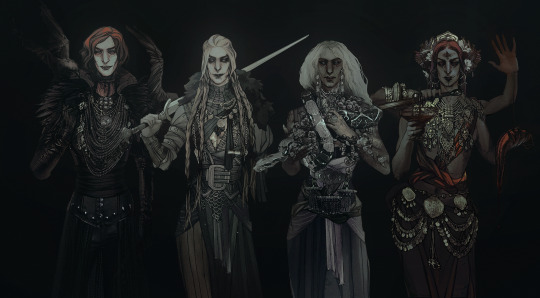


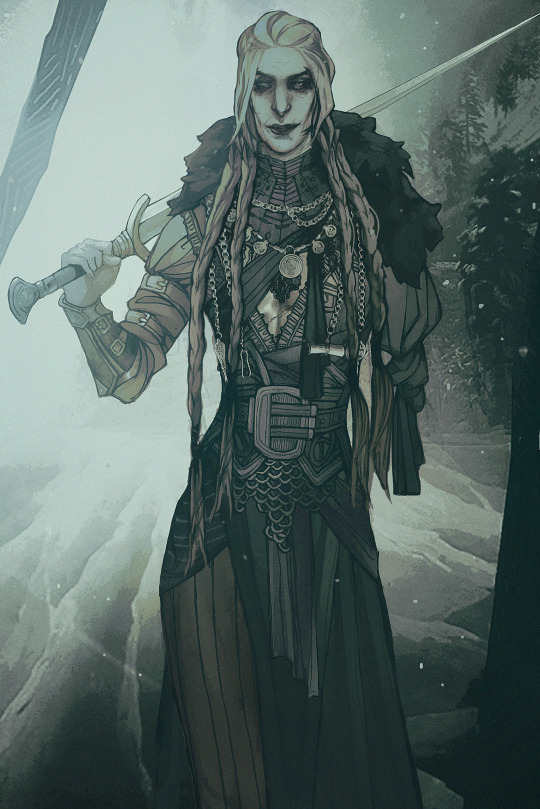

Divines AU
There is was my personal practice in character design, unfinished as my mental prosperity made some various recent culpits of wartimes and mundane events, through which such common-toned, such single-minded project thrived. It is a heartbreak for me - to not finish this one with the last two pieces as I feel that, at this point, this tones are burnt enough.
The thought here was to create an enraged and malicious design of the main LI's with delightful tones of dark fantasy and folk elements. At some point or another they started outstand each other in senses, through the general was to create an alternative currency of visional narrations, whether they represent any sort of the servants of the divine power of domes - or be an enigmatic epitomes of such.
Nadia there has the bright and sharp tone of native and chtonic goddess of primar feminity, and her personification is simplest, yet brightest and more harmonic in most of tones, as she was first. Tried to create sensual and dark personification of red-hot control of divine creature - with bloodied hands, sage-filled flesh and cold but serene and plassid expressions. Her design has clear foreshadowing of origins, both of the incandescent eye of her forehead and devilish tongue and goblets of blood in stained, still hands.
Ilya was second - with some achronic, divided from original design points of view and perception. He was an ill omen of dark ages, of Grozny century of seventeen, and was created as a gentle carrier of dark divines, as an helping hand of Blight and Pestilence. Julian here was equally loving and malicious, a face in heart more suitable to the urban horrors of victorian ages, with delectable shape of smog and leather, of tall and feathered figure of the Omen. From the point of Morana, goddess of dark ritual and ill amends, it goes into the tsar's ruffian - and after to the carrier of a dark age.
While Asra was the most detailed and passionate at several tones, he also was the most gentle and demure in such. They were created as the carrier of Desire, of a road with no end, of an ache and blight of both flesh and mind, a creature alike to a Djinn - of divine appetite,of arts and love, fullfilled and shaped and created as appetency incarnate. The details were to shape an primoridal, chtonic nature - of the Serpent of Paradises, bearer of vines and bloods, forbidden knowledges and omens, of a ancient nature that is nurturing and ravenous alike.
Lucio Morgasson here was created as an alternative, boundless and timeless version of his image itsef - achronic and deranged, morbid and voracious, he is most image of his mother than anytime else. He was designed as northern legend - or an apparation of forbidden past, heavy will of old nordic atrocity. This image is full of control, too - ravenous creature in pall of obstinacy, cold-headed rigority, a gall of flime and frost all in one. There was a decent detail of traditional image - blood-shoted, unseeing eye of pestilence, a sleeve that is turned into knot - sacrifice of a man to himself, but instead of divine wisdom of magic there is rust and tyranny of appetites.
#divine au#nadia satrinava#julian devorak#lucio morgasson#asra alnazar#the arcana game#dark fantasy#gothic#fan art#character redesign#mythology#folk#character sprite
302 notes
·
View notes
Text
330: Clara Rockmore // Theremin
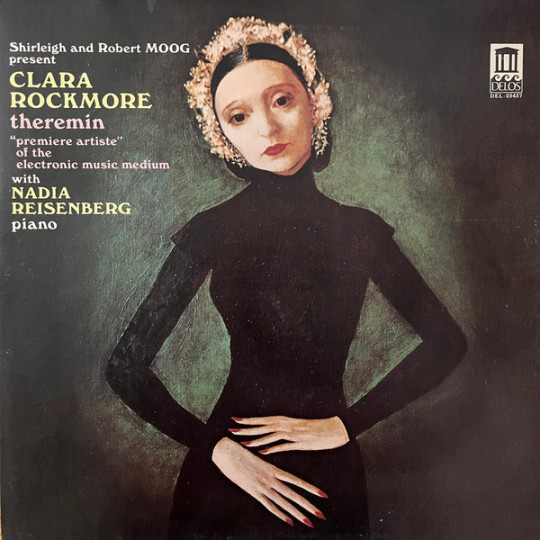
Theremin
Clara Rockmore
1977, Delos (Bandcamp)
100 years since its invention, the theremin remains an oddity. It is in every respect an antiquated piece of technology, and yet like the Tesla coil and the plasma globe it still provokes the primal wonder of science-as-magic. The advancements of a modern synthesizer unit are hidden from the eye—if you presented it to an unthawed person from the 19th century, they would at least be able to infer that the device is controlled using the buttons and keys. But the theremin player creates sound by coaxing an invisible magnetic field with their bare hands, as though they are pulling its warbling voice from the air itself—and indeed, inventor Léon Theremin’s artful original name for his instrument was the ætherphone.
youtube
To watch a performance by Clara Rockmore, the instrument’s foremost practitioner, is to see something that resembles a scene from a séance or a German Expressionist film. A petite, dark-haired woman with the eyes of an Orthodox Virgin Mary, she would stand ramrod straight behind the lectern-like theremin, nearly motionless save for the almost palsied-looking convulsions of her knotted hands and the tensing of her eyebrows, the only sign on her otherwise slack features of the intensity of her concentration. She looks as though she is forcing down the song attempting to leap from her throat until it screams through her fingertips like steam from a kettle. As synth pioneer Robert Moog explains in his liner notes to Rockmore’s 1977 LP Theremin, her absolute stillness was not a theatrical device but a requirement of playing the instrument: the theremin’s magnetic field encompasses not only the performers hands but their entire upper body, meaning that even a minor motion of the head will influence the instrument’s pitch. But the austere figure she cut no doubt contributed to her allure, the sense that she was herself as unearthly as the instrument she played.

Rockmore, a violin prodigy since age 5, took to Theremin’s invention sometime in the late 1920s. Her concerts popularized and legitimated the instrument, but it would be nearly a half-century before the Theremin LP, her first, was finally released. Produced by Shirleigh Moog and engineered by her husband Robert, one gets the sense that the Moogs are fans trying to correct an oversight, to record the album as it would’ve sounded if it had been made her during her prime. The results are captivating, even haunting. At times you may be fooled into thinking you’re listening to a recording of a human soprano from some decayed shellac disc; in other moments, you will be moved by how world-weary an electronic tone can sound. Rockmore is accompanied, as she had been since the beginning, by her sister Nadia Reisenberg on piano, and her selections focus on 19th and early 20th century compositions, with a heavy emphasis on the Romantics. A majority of the pieces here come from her fellow Russians, including Tchaikovsky, Glazunov, Rachmaninoff, and Stravinsky. My personal favourite of these is her take on Joseph Achron’s “Hebrew Melody.” Inspired by traditional laments, Rockmore’s theremin evokes the sobbing characteristic (krekhts) of Jewish vocal music, while her sister thunders and pirouettes on her piano in a classically Romantic style.
Theremin stands apart from other electronic classical records like Wendy Carlos’ Switched-On Bach because it never sounds wholly like a novelty despite the theremin’s high camp potential (and, for that matter, Rockmore’s). It is peculiar, and my fascination with it definitely originated in a perverse nostalgia for esoteric junk—but the somber beauty of the sisters’ performance wiped the smirk from my face from virtually the moment I dropped the needle.
330/365
#clara rockmore#theremin#leon theremin#robert moog#moog#shirleigh moog#electronic music#early electronic#romantic music#'30s music#'70s music#classical music#nadia reisenberg#music review#vinyl record#mississippi records#joseph achron#tchaikovsky#rachmaninoff#glazunov#achron#stravinsky
8 notes
·
View notes
Text
Intro under the cut

[image ID: a text divider. End ID]
Byi (before you Interact)
My instances are neuship, neu para/kink, anti contact, pro endo, radinclus(pro contradictory labels, etc. Not including radqueer identities)
We are multigenic system of 3 beings(one is dormant but she still counts)
Im a cat and sheep therian, and angelic/angelkin, i'm also a furry. I have other alterhuman identities that you can check on my pronouns.cc further in this post
You may call me "Lamb", or "Ash", or simply "cat". My gender is gxrl and cistrans, my xenogenders are angelkinic and invinepgender, my orientation is aroflux and bi-straight, my safe pronouns to use are she/its, you can also call me a he too. Im achronal but bodily a minor. My zodiac is leo(solar) and capricorn(ascendent), and my mbti is infj
My first language isnt english so i may commit grammar mistakes.
I won't engage in any kind of discourse and If you try to drag me into It, i'll instantly block you
I block antis and anyone who i don't like on sight
Asks and dms (direct messages) aren't encouraged but If you need to, they are open
-
Dni (do not interact)
I can't control who interacts, so anyone "can" interact with my posts, but, i, please, ask to not If: you're racist, ableist, xenosatanist, part of the radqueer movement, pro-c for non consensual paras, a map(nomaps are fine), a bestialist(non contact zoophiles are fine), anti recovery, anti endo, fakeclaimer, pro harassment, suibaiting, anti otherlink(funlink, copinglink, etc), anti furry, anti mspec mono/contradictory labels, anti liom(aldernic, chronosian, alterhuman, neurodivergences, etc)/mogai/lgbt, terf/radfem, BaB, LsL, GkG, exclusionist, "hardcore" proship, "hardcore" antiship, thinks fiction inherently affects reality, thinks fiction can't affect reality in any way, thinks paraphilias are inherently harmful, thinks paraphilias can’t be harmful, ai "art" supporter.
-
Qna (question and answer)
"You're pro para? You support zoos/maps/necros?"
No, im in general neu paraphilia and anti contact for non consensual ones, while i don't support zoos/maps/necros, i want them to get help and live their lifes as equal as any other being. But im against those who act on these paraphilias.
"What do you mean 'if you think fiction inherently affects reality'? And 'hardcore antiship?' You're a profic/proship?"
No, im actually neuship, why? Because i don't want to be associated with neither sides, wich both are very toxic. And i personally think that fiction doesn't affect reality, as long as you dont let it affect your reality. And i dont want to interact with antishippers that tell others to kill themselves and only post about complaining and reminding about proships. In the end i'm not proship neither antiship
"you identify as a cat, sheep and angel? Are you crazy?"
If what you call "Crazy" is to experience involuntary urges, insticts and other experiences and wish to fully embrance this part of me that makes myself, then yes, i am crazy. Sure, i know i'm in a human body, but my mind and soul is not, and If you don't agree with me, it's ok, everyone can have opinions, but please, kindly dni If you're not willing to learn that my ways of living aren't hurting anyone and i'm Just being myself.
“You’re a furry? You’re a zoophile”
Anthropomorphical characters aren’t irl animals that can’t give consent, so obviously not.
-
Asks and dms
I Will answer any ask that i feel comfortable to, If you need help with alterhumanity and other terms, feel free to ask me, either on my dm or on the ask inbox, about it.
If you wish and try to insult me on my dms or asks because of my beliefs or identities, kindly dni
1 note
·
View note
Photo

Commission for Krav and Achron <3
Commissions are open!
My Furaffinity
My Deviantart
#commission#aludra#aludra art#aludrakijurorin#kiss#furry#cute#furry couple#mouse#canine#krav#kravlin#achron#forehead kiss#snow#winter#digital art#art
3 notes
·
View notes
Video
youtube
https://www.youtube.com/watch?v=MLW_DlA6ZTQ
In the rush of Jewish musical creativity in the early twentieth century, Josef Achron seems to have been forgotten a bit. He was born in Lithuania in 1886 and eventually emigrated to the United States. He was trained as a violinist, and later as a composer, studying both violin and composition in St. Petersburg. In 1911, he joined the Society for Jewish Folk Music, which was an organization of Russian-Jewish classical composers who essentially wanted to take part in the fashion for “nationalist” music (that is, music that expressed the existential nature of an ethnic group or nationality) and create a specifically “Jewish” form of Western art music.
Achron’s most famous piece is “Hebrew Melody,” but that certainly wasn’t his only Jewish classical composition. This is his “Hebrew Lullaby,” the second of a suite of two pieces where he’s not really working with an extant Jewish folk song, but he’s trying to write classical music that “sounds Jewish.” What do you think? Does this say “Jewish” to you?
3 notes
·
View notes
Text
Patch Has Issues: Dungeon #2
Issue: Dungeon #2
Date: November/December 1986 (Pretty sure my Christmas haul that year was full of dope toys from The Transformers movie/show.)
The Cover:

(Use of cover for review purposes only and should not be taken as a challenge to status. Credit and copyright remain with their respective holders.)
Ah, Clyde Caldwell. He, Larry Elmore, Jeff Easley, and last issue’s Keith Parkinson were the mainstays of TSR’s amazing stable of artists. I have a soft spot for Caldwell. He did the covers for the D&D Gazetteer series, which means his work emblazoned some of my absolute favorite books from my middle school years. (At the time I had the whole series except the two island books, GAZ 4 & GAZ 9 (which I’ve since collected), plus the Dawn of the Emperors box set. My favorites, for the record, were GAZ 3, 5, 10, and 13. I...may like elves...a little too much.) And even as I sit here, other covers demand to be named. The very first Dragonlance adventure, the iconic Dragons of Despair? The Finder’s Stone trilogy? The first Ravenloft box? Dragon #147? Yep, he did those covers too. He was amazing.
But hoo-boy, we also have to talk about the not-amazing parts. Once Caldwell settled on a way of doing things, that’s how he did them. Points for consistency, but man, he had tropes. Even his tropes had tropes. He had a way of painting dragon’s wings. He had a way of painting swords and boots. He had a way of painting jewelry, and belts and coins—ovals upon ovals upon ovals.
And his way of painting women was with as few clothes as possible. Everything I said about Parkinson last entry? Yeah, that goes double for Caldwell. He never paints pants when a thong will do. His take on the reserved and regal Goldmoon—thighs as long as a dwarf and bronzed buttcheeks exposed—reportedly left Margaret Weis in tears. Magic-users (God, I hate that term) famously couldn’t use armor in D&D and AD&D, but Caldwell’s sorceresses pretty much stick to gauze just to be safe. And the Finder’s Stone trilogy I mentioned above? Yeah, the authors of Azure Bonds took one look at Caldwell’s cover art and literally had to come up with in-text reasons why the heroine Alias—one of the most surly woman sellswords in existence—would wear armor with a Caldwell boob hole.
Don’t get me wrong, I love cheesecake as much as the next dude. (Actually that’s not true; I came up in the grunge ’90s—our version of cheesecake was an Olympia brunette in three layers of thrift store sweaters reading Sandman while eating a cheesecake. Hell, that’s still my jam.) But context matters. The sorceress from “White Magic,” Dragon #147’s cover, may barely be wearing a negligee, but she’s also in the seat of her power and probably magically warded to the hilt—she can wear whatever she damn wants; it’s her tower. So no complaints there. But this cover’s pirate queen Porky Piggin’ it seems like an unwise choice. (The friction burns alone from clambering around the rigging…)
It’s clear from reading The Art of the Dragonlance Saga that TSR was trying to turn the ship around when it came to portrayals of women in fantasy, however slowly. And in Caldwell’s defense and to his credit, he definitely delivered women with agency—in nearly every image, they are nearly always doing something active and essential. They just tend to be doing it half-dressed.
Which is all a way of saying I dig this cover—the explosion, the churning sea (even if it does more look like snow drifts than waves), the sailors all running to the rail to look—but yeah, that pirate captain needs to put on some damn pants.
The Adventures: Before we get started, I have to note that though we’re only an issue in, already the magazine feels more noticeably like the work of editor Roger Moore. This is 100% a guess, but it really feels to me like Dungeon #1 was made of adventures that the Dragon office already had laying around, whereas Dungeon #2 was composed of adventures that Roger Moore and the new Dungeon team had more of a hand in sifting through. (He also has an assistant editor this time in Robin Jenkins, which had to have helped.) Even the cartography looks better. Again, I have zero confirmation of this, but the feeling is strong.
“The Titan’s Dream” by W. Todo Todorsky, AD&D, Levels 5–9
PCs visiting an oracle accidentally walk right into a titan’s dream and must solve some conundrums to escape. What an awesome concept this is! (Spoilers for “Best Concept” section below.) It’s a shame I don’t like this more.
First of all, dreamworld adventures are really hard to do well. And for them to work, there usually need to be real stakes—and not just “If you die in the dream, you die in real life!”—and/or a real connection to the PCs in your campaign. The latter, especially, is really hard to pull off in a published adventure; typically it’s only achieved through tactics that critics deride as railroading. (For instance, @wesschneider’s excellent In Search of Sanity does a great job of connecting the characters to their dream adventures...but it does that by a) forging the connection at 1st level, and b) pretty strongly dictating how the adventure begins and how the characters are affiliated. It works, but that’s high-wire-act adventure writing.)
Being a magazine adventure, “The Titan’s Dream” doesn’t have that luxury—it’s got to be for a general audience and work for most campaigns. That unfortunately means the default “Why” of the adventure—a lord with a child, a wedding, and an alliance at stake hires the PCs to chat with a wise titan—is little more than that: a default.
On top of that...I cannot get excited about anything Greek mythology-related. To me, just the fact I’m seeing it is a red flag.
Look, Greek mythology is why I got into this hobby. Hell, it’s why I got into fiction, period. (For some reason I somehow decided I had no use for fiction books targeted to my age, with the exception of Beverly Cleary. Then in 4th(?) grade, I got a copy of Alice Low’s Greek Gods and Heroes, and the rest is history.) But Greek mythology is often the only mythology anyone knows. When people think polytheism, that’s where most people’s minds go. Which is why, if you ever played D&D in the ’80s, I pretty much guarantee your first deity was from that pantheon. (In my first game, my first-level cleric pretty much met Ares and got bitch-slapped by him, because that’s what 4th-grade DMs do.)
So to me, putting Greek deities or titans in your adventure is the equivalent of putting dudes riding sandworms into your desert adventures—you can do it, but you better blow me away, because that is ground so well trod it’s mud. And this one doesn’t do the job.
The format is three dreams, each with five scenes. Parties will move randomly—a mechanic meant to represent dream logic (or lack thereof)—through these scenes, until all the scenes from one dream have been resolved. This is actually kind of fascinating, and I wonder how it would play at the table—I have a feeling observant players will dig it, but others may find the mechanism’s charm wears off quickly, especially if they have difficulty solving the scenes or get frustrated with the achronicity of events. I also like that every scene has a number of possible resolutions, so the PCs aren’t locked into achieving a single specific objective like they were stuck in a computer game.
But...I can’t shake the feeling of weak planning and execution (or even laziness?) that stayed with me throughout the adventure. Like, okay, the first adventure is a cyclops encounter out of the Odyssey. Cool! But then...why does the Titan follow it up with pseudo-Norse/Arthurian encounter? Did the Odyssey not hold the author’s attention? (Nor the Iliad, the Aeneid, or Metamorphosis? Really?) And then why is the third dream “drawn from the realm of pure fairy tale”? Like, were you out of pantheons? Horus didn’t return your calls? Or be more specific—why not German fairy tales, or Danish, or French Court, or Elizabethan? It feels like a class project where one group was on point, one group got the assignment a little wrong, and one didn’t even try.
Again, it’s not even that this adventure is bad—I honestly can’t tell if it is or not; I’m sure a lot of its success is determined at the table. And I could totally see throwing this at a party if I was out of inspiration that week or we needed a low-stakes breather before our next big arc. But the instant I think about it for more than a second, it all falls apart for me.
Have any of you tried this one? Let me know what you thought. And for a similar exploration into dream logic/fairy tale scenarios, I recommend Crystal Frasier’s The Harrowing for Pathfinder.
“In The Dwarven King’s Court” by Willie Walsh, AD&D, Levels 3–5
Willie Walsh is a name we’re going to see a lot more in issues to come—he’s a legendarily prolific Dungeon contributor, delivering quality, typically low-level, and often light-hearted or humorous adventurers issue after issue after issue. His first entry is a mystery with a time limit: A dwarf king is supposed to make a gift of a ceremonial sword to seal a treaty, but the sword has vanished. Brought to the king’s court courtesy of a dream, adventurers must find the sword and the surprising identity of the culprit before the rival power’s delegation arrives.
At first I was going to ding this adventure for its “What, even more dreams this issue?” hook...but here’s the thing with Walsh—never judge his modules until you reach the final page. Nearly every time I’m tempted to dismiss one of his sillier or more random adventure elements, it turns out that it makes sense and works just fine. In this case, the cause of the dream is haunt connected to the mystery, and I feel dumb for being all judgy.
So anyway, the PCs are given leave to search for the stolen object and the thief, but of course it turns out there is a whole lot of light-fingeredness going around. As Bryce (see below) puts it, “It’s like a Poirot mystery: everyone has something to hide.” This castle has as much upstairs-downstairs drama as any British farce, with nearly every NPC having either a fun personality and/or a fun secret (and with the major players illustrated by some equally fun portraits) that should make them memorable friends and foils for PCs to interact with. Not to mention the actual culprit is definitely a twist that will be hard explaining to the king...
GMs should be ready to adjust on the fly, though—a) it’s a lot of characters to juggle, and b) since the PCs are 3rd–5th level, the right spells or some lucky secret door searches could prematurely end the adventure as written. You may want to have some last-minute showdowns, betrayals, or other political intrigue outlined and in your back pocket if what’s on the page resolves too quickly.
Overall though, I’m a big fan of this adventure, and look forward to the rest of Walsh’s output. Also, given the dwarven focus and the geography of the land, this adventure could be a very nice sequel to last issue’s “Assault on Eddistone Point.”
“Caermor” by Nigel D. Findley, AD&D, Levels 2–4
Look at this author’s list of writing credits! Findley was amazingly prolific, and his work was pretty high-quality across the board, as far as I know. I particularly loved the original Draconomicon, one of the first and only 2e AD&D books I ever bought as a kid. I also loved his “Ecology of the Gibbering Mouther” from the excellent Dragon #160, and some of his Spelljammer supplements are currently sitting upstairs in my to-read pile, recently purchased but as yet shamefully untouched.
Now look at his age at the time of his death. Life is not always fair or kind.
(Speaking of unkind, man is the bio in this issue unfortunate in retrospect: “[H]e write for DRAGON® Magazine, enjoys windsurfing, plays in a jazz band, and manages a computer software company in the little time he has left.” As Archer would say, “Phrasing!”)
Anyway, this adventure is simple: An otherworldly force has been murdering the locals. The locals have pinned the blame on a handsome bard from out of town, and their own prejudices and general obstinacy are sure to get in the way of the investigation—that is, if the true culprits, some devil-worshipping culprits and and an abishai devil, don’t get in the way first.
All in all, this is a tight, well-written adventure, so I don’t have much to say about it, other than that if you like the idea of sending your party to help out some young lovers and save some faux-Scots/Yorkshiremen too stubborn to save themselves (and maybe slip in a valuable lesson about prejudice and xenophobia as well), this is the adventure for you.
One thing that does jump out to a contemporary reader, though, is the comically overpowered nature of the baddie pulling the strings in this adventure: Baalphegor, Princess of Hell (emphasis mine). Overpowered, you-won’t-really-fight-this-NPC happens with a lot of low-level adventures, when the writers want a story more epic than characters at the table can handle or are trying to plot the seeds for future evils. But still, any princess of Hell would already be a bit much...but an 18-Hit Dice, “supra-genius”, the Princess of Hell? Like, what the f—er, I mean, Hell?
If you use the adventure as written, the only way to have Baalphegor’s presence make sense is to eventually reveal that the area is an epicenter of some major badness. (Maybe that explains the lost nation of evil dwarves in the adventure background.) For a good model on how to seed early adventures in this matter, Dungeon’s Age of Worms Adventure Path and Pathfinder Adventure Path’s Rise of the Runelords AP, both from Paizo, are exemplars of small-town disturbances that eventually have world-shaking implications.
It’s also fascinating in retrospect to note Ed Greenwood’s massive impact in the hobby. Any article that appears in Dragon has the sheen of being at least semi-official, but it’s clear that Greenwood’s content was a cut above even that. In this case, an NPC from a three-year-old article of his is not just treated as canon, but also supplies the mastermind behind the adventure! It’s no surprise that in the following year his home campaign, the Forgotten Realms, would soon become AD&D’s newest and then its default setting.
Two final thoughts: 1) There’s some fascinating anti-dwarf prejudice in this article. Nearly every mention of dwarves paints them as exceptionally greedy and/or villains. And 2) how did one even begin to balance adventures in those days? This adventure is for “4–8 characters of 2nd–4th level.” There are a lot of difference at the extreme ends of those power scales…
“The Keep at Koralgesh,” by Robert Giacomozzi & Jonathan Simmons, D&D, Levels 1–3
One of the problems of BECMI D&D being known as “basic D&D” is that writers often assumed the players to be basic (that is, younger/new) as well. Which probably accounts for some of the early suggestions to the DM we get at the beginning of this adventure—like some pretty patronizing advice along the lines of not immediately announcing to PCs what the pluses are on their magical swords.
Fortunately, after that the article settles down and gives us Dungeon’s first real D&D adventure. In fact, not just real, but massive: 20 full pages of content—nearly half the issue! It’s a fully fledged dungeon crawl that has the PCs taking advantage of the summer solstice to open a shrine door that will lead them inside a long-ruined keep said to hold great treasure.
Now, I imagine in the coming installments it’s going to seem to many of you like I’m grading D&D adventures on a curve, because of my love for the system and the Known World/Mystara. That’s a fair accusation, but a better way to consider it is that I’m reviewing D&D adventures for what they are—adventures from a separate system, with a more limited rules system and palette of options than AD&D. You don’t go to a performance of Balinese shadow puppetry and compare it against Andrew Lloyd Webber; you look at it for what it achieves in its own medium. Since they appear side-by-side in the same magazine, comparison is going to be inevitable, but that’s with the understanding that AD&D was the kid coloring with the 64-crayon box of Crayola, while D&D was getting by with just eight.
On its own terms then, “The Keep of Korgalesh” is a decent, if not superlative, success. I love that it’s practically module-length and that we get three complete levels—a far cry from the previous issue’s side-trek-at-best, “The Elven Home.” We also get two new monsters, which absolutely fills my inner BECMI D&D player with glee. And I like that what starts as a dungeon crawl/fetch quest evolves into a “kill the big bad thing” and “find out what really happened to this city.”
There are issues, though. If the whole city was destroyed, getting to see some of it besides the keep would have been nice. Some of the ecology for the dungeon inhabitants is questionable. There pretty much wasn’t a single pool or fountain in this era of D&D adventure design that wasn’t magical, and this adventure was no exception. One of the new monster’s names makes no sense except that “tyranna” and “abyss” are cool words (I mean, I guess you could read that as “tyrant of the depths,” but still…) And there are painfully obvious borrowings from other works, especially Tolkien—a door that only opens at solstice, a lake monster, an orc with a split personality that is clearly a Gollum homage, etc.
What this adventure really needs is stakes—just something to give it a bit more oomph beyond the dungeon crawl. (Finding a blacksmith’s lost hammer is the hook offered in the adventure but it’s pretty flimsy.) Perhaps the PCs are some of Kor’s last worshippers, and clearing out the dangers here and resanctifying his temple is one of their first steps toward returning him to prominence. Maybe the PCs’ grandparents were involved in the city’s demise and restoring Koralgesh will restore the families’ honor. Or you could keep it simple and have a band of pirates or a rival adventuring group also trying to clean out the keep, turning it into a race (with the tyrannabyss causing the scales of fate to wobble at appropriately cinematic moments).
So the final analysis is this is a decent dungeon crawl upon which you can build a good adventure. The real reward of this module isn’t treasure; it’s finding out just what happened to Koralgesh. But for that to matter, it needs to tie into the PCs’ pasts, futures, or both.
BONUS CONTENT FOR KNOWN WORLD/MYSTARA NERDS: Kor is almost certainly a local name for the sun god Ixion. The chaotic deity Tram is probably a local version of Alphaks, though Atzanteotl is another strong candidate, especially since deceit was key to the pirates’ success. Koralgesh could be located somewhere on the Isle of Dawn, the northern coast of Davania, or an Ierendi/Minrothad Isle that those nations haven’t made it a priority to rebuild.
Best Read: “Caermor.” Nigel D. Findley was a pro.
Best Adventure I Could Actually Run with Minimal Prep: “The Keep at Koralgesh,” as a well-written, straight-ahead dungeon crawl. Every other adventure here relies on a pretty strong handle of very mobile NPCs and their motivations, or a Titan’s dream mechanics.
Best Concept: “The Titan’s Dream,” as noted above. It’s a great idea very worth exploring, even if I wasn’t about the execution we got in this case.
Best Monster: This was actually a monster-light issue. Despite some awesome art for the tyrannabyss, I have to go with the epadrazzil, a scaly ape from a two-dimensional plane of existence that has to be summoned via a painting. All of those details are just so wonderfully and weirdly specific it has to win. (Extra points for anyone who noticed the thoul—a classic D&D monster (though it did make its way into AD&D’s Mystara setting) born from a typo.)
Best NPC: Since this is a role-playing-heavy issue, there are a bunch of contenders, and the final verdict will go to whoever your party sparks to at the table. Obviously King Baradon the Wise should get the nod for [spoiler-y reasons], but I also really like the opportunity the executioner Tarfa offers, thanks to his incriminating goblet and how it might bring the PCs to the attention of a far-off assassin’s guild at just the right level.
Best Map: All together the maps from “The Keep at Koralgesh” form an extremely appealing whole. But for best single map I have to go for the palace of Mount Diadem—that is a bangin’ dwarven demesne.
Best Thing Worth Stealing: Jim Holloway’s illustrations of dwarves. Good dwarf, gnome, and halfling art is hard to find, and even the good stuff often leans stereotypical. While Holloway’s art is often humorous—I have a feeling he and Roger Moore jibed really well, though that’s totally a guess based purely on what assignments he got handed—his dwarves, especially in this issue, are fresh, specific, and unique. You could identify them by their silhouettes alone—always the sign of good character art. If you need an image of a dwarf NPC to show the players, “In the Dwarven King’s Court” is a great first stop.
Worst Aged: Female thong pirates on magazine covers. Also using the actual names of actual mental illnesses in game materials.
What Bryce Thinks: “This seems to be a stronger issue than #1, although half of the adventures are … unusual.”
Bryce actually almost likes “The Titan’s Dream,” confirming my loathing of it. He in turn loathes “In the Court of the Dwarven King.” Like me, though, he is pro-”Caermor” and sees potential in “The Keep at Koralgesh.” (Also credit where it’s due: I might have missed the condescension at the start if he hadn’t called it out.)
So, Is It Worth It?: If you’re a Clyde Caldwell fan, this issue might be worth searching out in print. So much of Caldwell’s work from this era was dictated by product needs, cropped and boxed up in ads, or shrunk down to fit on a paperback cover. So to get this cover in full magazine size, with only the masthead tucked up top to get in the way—that could be well worth a few bucks to you.
Also, if you’re BECMI/Rules Cyclopedia-era D&D fan (or know someone who is), again, this one might be worth having in print. “The Keep at Koralgesh” is a legit, proper BECMI D&D adventure, spanning 20 whole pages and with two new monsters to boot. I would have practically have cried if someone had given 7th-grade me this.
Beyond that you can probably just rely on the PDF. But both “Caermor” and “In the Dwarven King’s Court” have strong bones worth putting some modern muscle and skin on.
Random Thoughts:
The Caldwell cover painting was also used for the Blackmoor module DA4 The Duchy of Ten. PS: I’m not trying to tell you what to do or anything, but if you do happen to run across a physical copy of The Duchy of Ten or and of the DA modules, holla at ya boy over here.
Since this is our second issue, we now have a “Letters” column. Turns out Dungeon had been announced in Dragon #111 with a really detailed set of writer’s guidelines; most of the correspondence is questions re: those. In the process of answering, we get some surprisingly frank talk about payment. The $900 for a cover seemed low until I converted it to 2018 dollars, and ~$2,000 does seem right to my ignorant eye. I then made the mistake of converting my current salary to 1986 dollars and felt a lot worse about myself and what I’ve achieved.
Apologies this took so long to post. I had the issue read by early October and most of this review written with the next week or two after...but then I got involved in dealing with a 4.5 week hospitalization and aftermath...and then a second still-ongoing hospitalization...and even though I only had about four paragraphs left I just couldn’t find time to put a bow on it.
Notable Ads: The gold Immortals Rules box for D&D. (I also still don’t have that one yet, and Christmas is coming. Just saying, guys, if you happen to find one in your attic.) ;-) Also an ad for subscribing to Dungeon itself, starring “my war dinosaur, Boo-Boo.” No, really.
Over in Dragon: Beneath a glorious cover, Roger Moore is the new editor of Dragon #115, three authors (including Vince Garcia, who I like a lot) share credit on a massive six articles about fantasy thieves, a famous article proposing that clerics get the weapons of their deity (people were still talking about it in the “Forum” column when I was buying my first issues two years later), and a look at harps from the Forgotten Realms (notable because behind the scenes Ed Greenwood’s home setting was being developed for the AD&D game for launch in 1987.) A photographic cover and a 3-D sailing ship are served up in Dragon #116, along with maritime adventures, more Ed Greenwood (rogue stones), and articles for ELFQUEST, Marvel Super Heroes (Crossfire’s gang), and FASA’s Dr. Who game (looking at all six(!) doctors). (Incidentally, I had an Irish babysitter around this time who first mentioned Dr. Who to me—I wish I’d explored more but I was too young to understand what I’d been offered.)
PS: Yes, I’ve heard about the upcoming Tumblr ban. It is a terrible idea that will affect way too many of my readers. It shouldn’t affect me much (and I have all my monster entries backed up at the original site), but I will keep you posted as I learn more, particularly if I find you, my readers, packing up and going elsewhere.
#daily bestiary#patch has issues#pathfinder#paizo#3.5#dungeons & dragons#dungeons and dragons#d&d#dnd#ad&d#becmi#dungeon#dungeon magazine
95 notes
·
View notes
Photo

La playlist de l'émission de ce jeudi matin sur Radio Campus Bruxelles entre 6h30 et 9h: Georges Perec & Claude Piéplu "Lieux, un projet (Confié à Gérard Macé) / Tentative de description de choses vues au carrefour Mabillon le 19 mai 1978 / 475 véhicules à deux roues, dont..." (Georges Perec/André Dimanche Éditeur/INA/1997) Clara Rockmore & Nadia Reisenberg "Achron: Hebrew Melody" (The Art of the Theremin/Mississippi Records/1975-2009) ZNR (Hector Zazou & Joseph Racaille) "Un véritable monstre à musique" (Traité de mécanique populaire/Invisible Records/1978) Moondog "Oasis" (The Viking of Sixth Avenue/Honest Jon's Records/1953-2004) Ben LaMar Gay "Aunt Lola and the Quail" (Open Arms to Open Us/International Anthem/2021) Eddie Chacon "Trouble" (Pleasure, Joy and Happiness/Day End Records/2021) Caetano Veloso "Da maior importância" (Qualquer Coisa/Philips/1975) Tracey Thorn "Simply Couldn't Care" (A Distant Shore/Cherry Red Records/1982) Madame Patate "Poisson Lune" ("Jolis choses" Hommage à Mami Chan/InPoly Sons/2021) George "The Living Sound" (A Week of Kindness/Pickled Egg Records/2005) Lael Neale "Sliding Doors & Warm Summer Roses" (Acquainted With Night/Sub Pop Records/2021) Françoise Hardy "Oh oh chéri" (Succès/Mondio Music/1962-1970) Herman Dune "Song of Samuel" (7" I Wish That I Could See You Soon/Source Etc/2007) Lou Reed "HookyWooky" (Set the Twilight Reeling/RHINO/1996-2021) The Fall "Eat Y'self Fitter" (50,000 Fall Fans Can't Be Wrong - 39 Golden Greats/Beggars Banquet/1983-2004) The Sound "I Can't Escape Myself" (Jeopardy/Korova/1980) Morphine "You Speak My Language" (Good/Rykodisc/1993) Richard Youngs "The Valley in Flight" (Beyond the Valley of Ultrahits/Jagjaguwar/2010) Hany Mehanna "Less Al Thulatha" (Music for Airplanes - A collection of instrumental showpieces and scores for Egyptian films and TV-series (1973-1980)/Souma Records/2021) Coil "The Last Amethyst Deceiver" (The Ape of Naples/Threshold House/2005) Gérard Manset "La mort d'Orion" (La mort d'Orion/EMI Records/1970-1996) Tortoise & Bonnie "Prince" Billy "Love is Love" (The Brave and the Bold/Domino Recording Company/2006) https://www.instagram.com/p/CX0uoe5tP97/?utm_medium=tumblr
0 notes
Text
I have always hated having to come up with an "artist's statement" to accompany my paintings.
"This is called 'Foxlight'. It's, uh, taxidermied foxes at the Field Museum of Natural History. There's skeletons too. Oh, and it's egg tempera."
If I wanted to write philosophy I'd have become a philosopher.

34 notes
·
View notes
Text
May 13 in Music History
1723 FP of Feo's "Morano e Rosina" Naples.
1726 Death of Italian castrato Francesco Antonio Pistocchi.
1726 FP of Hasse's "Il Sesostrate" Naples.
1735 Birth of composer Horace Coignet.
1746 Birth of American composer Oliver Brownson.
1767 FP of Mozart's "Apollo et Hyacinthus" Salzburg.
1756 Birth of composer Wojciech Zywny.
1776 Birth of composer Charles Ots.
1776 Birth of composer Rodrigo Ferreira da Costa.
1827 FP of Donizetti's "Otto Mesi in due ore, ossia Gli Esiliati in Siberia" Naples.
1833 FP of Mendelssohn's Symphony. No 4, Italian. Composer conducting, in London.
1835 Death of Italian tenor Serafino Gentili.
1842 Birth of composer Arthur Seymour Sullivan, London England.
1846 Birth of Italian singing teacher Alberto Antonio Visetti.
1847 Birth of Norwegian composer Johannes Haarklou in Førde.
1854 Birth of composer Paul Klengel.
1859 Birth of Danish opera composer August Enna in Nakskov.
1862 FP by the Theodore Thomas Orchestra in NYC. American premieres of Wagner's Flying Dutchman Overture and Liszt's orchestration of Schubert's Wanderer Fantasy.
1864 Birth of French bass Marius Chambon in Venissieux-les-lyon.
1866 Birth of Hungarian violinist Ottokar Novacek in Fehertemplom.
Belgian #soprano Lucy-Bertrand Berthet.
1867 FP of Sullivan's "Cox and Box" London.
1868 FP of Grandval's "La Pénitente" Paris.
1868 Birth of composer Paolo Gallico.
1868 FP of SaintSaëns' Piano Concerto No. 2. Rubinstein conducts.
1872 FP of Hrimalý's "Zaklety Princ" Prague.
1874 Birth of English bass-baritone Robert Radford in Nottingham.
1874 Birth of composer Henry Clough-Leiter.
1876 Birth of composer Raoul Laparra.
1876 FP of Denza's "Wallenstein" Naples.
1877 FP of Cesar Frank´s Les Eolides at a Lamoureaux Concert in Paris.
1881 Birth of Hungarian soprano Ilona Durigo in Budapest.
1886 Birth of Latvian-American composer and violinist Joseph Achron.
1898 Birth of German baritone Fritz Schaetzler in Nurenburg.
1900 Death of German composer and conductor Herman Levi in Munich.
1906 Birth of American soprano Maxine Stellman in W. Brattleboro, VT.
1908 Birth of American pianist Beveridge Webster in Pittsburgh.
1913 Birth of composer Cedric Thorpe Davie.
1913 Birth of Romanian conductor Constantin Silvestri.
1913 Birth of American organist William Schwann in Salem IL.
1916 Death of American soprano Clara Louise Kellogg.
1919 Birth of German baritone Heinz Borst in Stuttgart.
1920 Birth of English flutist Gareth Morris.
1920 FP of Weingartner's "Die Dorfschule" and "Meuster Andrea" Vienna.
1921 FP of Stolz' "Die Tanzgräfin" Vienna.
1922 FP of Szymanowski's "Hagith" Warsaw.
1927 Birth of Belgian bass Louis Hendrikx in Antwerp.
1932 Birth of Russian conductor Yuri Ahronovitch in Leningrad.
1933 Birth of American composer Alden Ashforth.
1933 Birth of composer Stig Gustav Schonberg.
1935 Birth of composer Yizhak Sadai.
1935 Birth of composer Nigel Butterley.
1935 Birth of American baritone Dominic Cossa in Jessup, PA.
1937 Birth of American conductor Judith Somogyi in NYC.
1938 Birth of Rumanian tenor Ludovic Speiss in Cluj.
1940 Birth of German bass-baritone Andreas Becker in Berlin.
1941 FP of Krenek's "Tarquin" Vassar College, Poughkeepsie.
1949 FP of Jeremiáš' "Enspígl" Prague.
1949 FP of Andrzej Panufnik's Sinfonia Rustica in Warsaw.
1949 Birth of English conductor and composer Jane Glover.
1950 Death of soprano Pauline De Ahna.
1950 FP of Badings's "The Night Watch" Antwerp.
1951 Birth of Dutch composer and pianist Guus Janssen in Heiloo.
1952 Death of Italian soprano Vera Amerighi Rutili.
1953 Death of Latvian tenor Hermann Jadlowker.
1955 FP of Dello Joio's "The Ruby" Bloomington, IN.
1956 Birth of Dutch composer Jan Willem van Dormolen in The Hague.
1957 Birth of English organist and conductor David Hill.
1961 Birth of Belgian bass Daniel Ottevaere in Brussels.
1963 FP of Still's "Highway 1, U.S.A." Miami.
1965 Birth of English violinist Tasmin Little.
1987 Death of Norwegian soprano Signe Amundsen.
1987 Death of bass Forbes Robinson.
1987 FP of John Harbison's Symphony No. 2. San Francisco Symphony, Herbert Blomstedt conducting.
1992 Death of tenor Gustavo Gallo.
1993 FP of Ellen Taaffe Zwilich's Bassoon Concerto. Nancy Groeres with Pittsburgh Symphony conducted by Lorin Maazel.
1995 Broadcast of Any Beach's opera Cabildo. PBS-TV's "Great Performances" conducted by Ransom Wilson.
1997 Death of American composer Bernard Brindel in San Francisco, CA.
2001 FP of John Harbison's North and South. Chicago Chamber Musicians.
2011 Death of cellist Bernard Greenhouse. Founding member of the Beaux Arts Trio.
0 notes
Text
While I am pretty sure charm bracelets existed before 1927 (Queen Victoria is said to have been fond of giving them as gifts), the girly fashions reporter for Judge magazine seems to rather endearingly only have discovered them in the September 17th 1927 column.
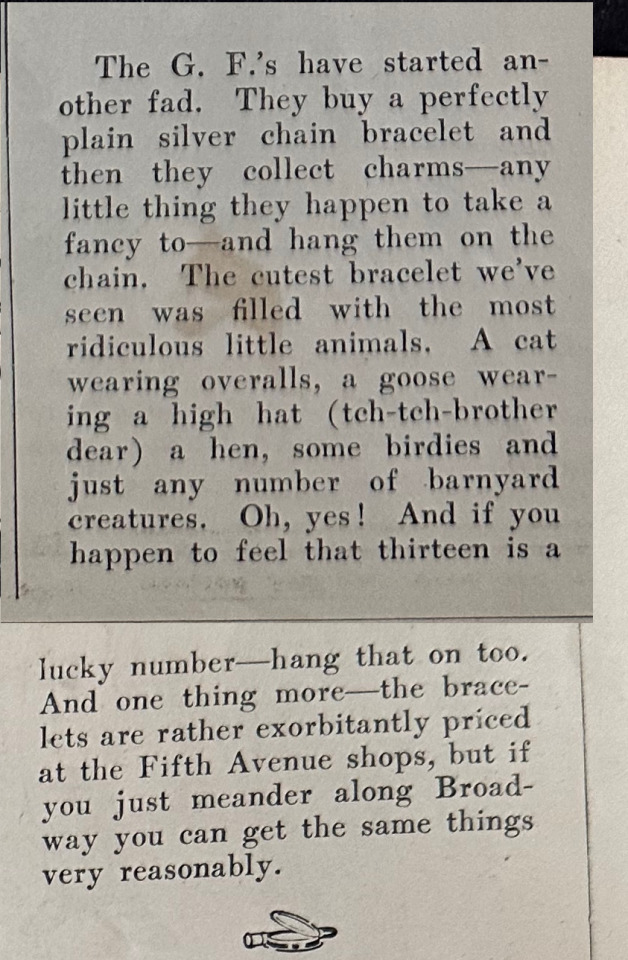
La Vie Parisienne seems to have existed to publish alternately and often simultaneously lascivious and critical cartoons about young ladies and to cluck over them judgementally, but one takes what sources one can find. Anyway, in this 1927 cartoon the young lady on the right appears to be wearing a charm bracelet as part of her dancing ensemble.
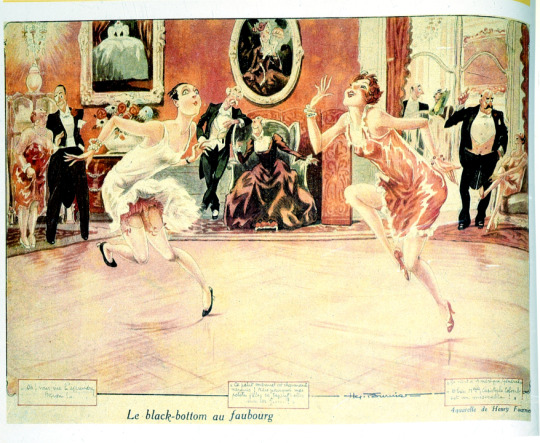
7 notes
·
View notes
Text
Just imagine...
"Ea-nāṣir, The Musical"
...and its first act finale big musical number: "Coppertunity Knocks."
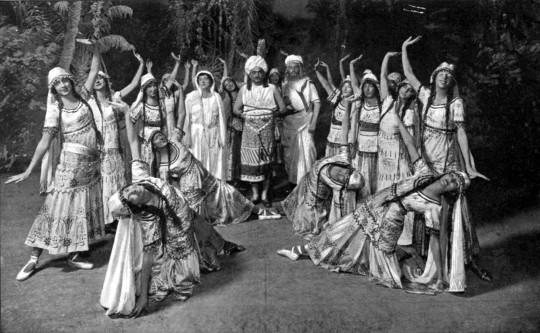
#Achronal Art#calling all musical theater kids#Ea-nāṣir#if only Saint-Saëns had known about Ea-nāṣir#Ea-Nasir#satire
17 notes
·
View notes
Text

Happy Sketchbook Sunday!
This is a roughly life-sized drawing of a cat skull I made yesterday. (Depending on your device, it may be showing up way bigger than the original drawing, which takes up something like a sixth of a page in my sketchbook)
The skull is inverted, resting on its top with natural daylight coming in from a window on the right.
So we're looking up through the jaw to the underside of the skull and braincase.
My handwriting at the top looks a little peculiar because I was scoonching my hand to avoid smudging the drawing. A professional artist, ladies and gentlemen!
#Sketchbook Sunday#Achronal Art#Cat skull#sketchbook#scientific illustration#graphite drawing#pencil art#anatomy#animal anatomy#cat anatomy#my kids keep saying I am a goth and I am not sure if they are joking or not
6 notes
·
View notes
Text
Hello, world
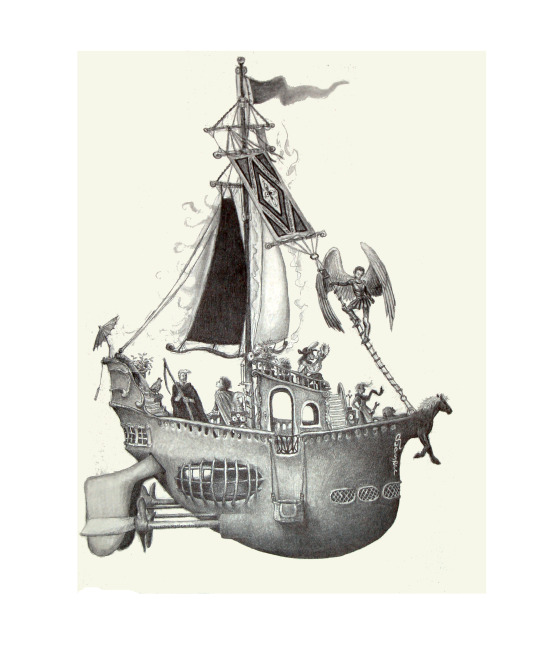
7 notes
·
View notes